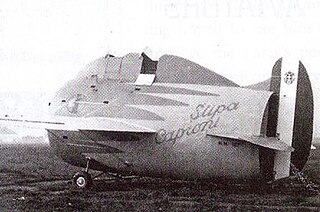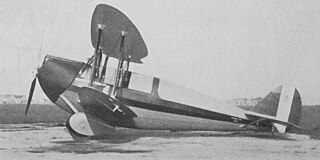
Caproni, also known as Società de Agostini e Caproni and Società Caproni e Comitti, was an Italian aircraft manufacturer. Its main base of operations was at Taliedo, near Linate Airport, on the outskirts of Milan.

The Caproni Ca.60 Transaereo, often referred to as the Noviplano (nine-wing) or Capronissimo, was the prototype of a large nine-wing flying boat intended to become a 100-passenger transatlantic airliner. It featured eight engines and three sets of triple wings.

The Caproni Ca.100 was the standard trainer aircraft of the Regia Aeronautica in the 1930s. Large numbers of this tandem, two-seat, biplane were built, powered by different engines.

The Caproni Ca.1 was an experimental biplane built in Italy in 1910. It was the first aircraft to be designed and built by aviation pioneer Gianni Caproni, although he had previously collaborated with Henri Coandă on sailplane designs.

The Stipa-Caproni, also known as the Caproni Stipa, was an experimental Italian aircraft designed in 1932 by Luigi Stipa (1900–1992) and built by Caproni. It featured a hollow, barrel-shaped fuselage with the engine and propeller completely enclosed by the fuselage—in essence, the whole fuselage was a single ducted fan. Although the Regia Aeronautica was not interested in pursuing development of the Stipa-Caproni, its design influenced the development of jet propulsion.

The Macchi M.70, was an Italian light biplane of the late 1920s built by Macchi.

The Caproni Ca.125 was a single-engine, tandem two-seat, touring biplane built in Italy in 1933. It could be operated either as a landplane or seaplane.

The Gianni Caproni Museum of Aeronautics is Italy's oldest aviation museum, as well as the country's oldest corporate museum. It was established in 1927 as the Caproni Museum by Italian aviation pioneer and aeronautical engineer, Giovanni Battista "Gianni" Caproni and his wife, Timina Guasti Caproni.

The Caproni Ca.193 was an Italian liaison and air-taxi aircraft that was offered to the Italian Air Force as an instrument flight trainer and to the Navy for liaison. Design work started in 1945 and only the prototype was built. It was the last aircraft the Caproni company designed and built in Milan.
The Caproni Ca.134 was a biplane reconnaissance aircraft built by the Italian company Caproni in the 1930s.

The Caproni Ca.16 was a single-engine monoplane designed and built by Caproni in the early 1910s.

The Caproni Ca.9 was a single-engine monoplane designed and built by Caproni in the early 1910s.

The Caproni Ca.6 was a single-engine biplane designed and built by Caproni in the early 1910s.

The Caproni Ca.7 was a proposed biplane designed by Caproni in the early 1910s.

The Caproni Ca.8 was a single-seat monoplane designed and built by Caproni in the early 1910s.

The Caproni Ca.13 was a two-seater single-engine monoplane built by Caproni in the early 1910s.
The Caproni Ca.66 and Caproni Ca.67 were Italian night bomber aircraft designed to re-equip the post-World War I Regia Aeronautica.
The Caproni Ca.103 was a biplane twin-engine bomber developed by the Italian company Aeronautica Caproni in the late 1920s.

The Caproni Ca.105 was a multirole high wing single engine monoplane developed by the Italian aeronautical company Aeronautica Caproni in the late 1920s.

The Caproni Ca.53 was an Italian prototype light bomber built in the last months of World War I.



















